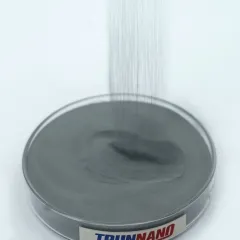- Home
- Products
- Elementary
- Boride Powder
- 3D Printing Powder
- Sulfide Powder
- Oxide Powder
- Carbide powder
- Nitride Powder
- Silicide Powder
- Hydride Powder
- Telluride Powder
- Selenide Powder
- Stearic Acid Series
- Phosphide Powder
- Nanoparticles
- Metal Alloy
- MAX Phase
- Lithium Battery Anode
- Surfactant
- Molecular sieves
- Concrete Admixtures
- Cladding of metals
- News
- Blog
- Contact
- About
High Purity Tin Sn Powder CAS 7440-31-5,99%
Overview of Tin Powder :
The appearance of tin powder is off-white, with a metallic luster, and its particle size varies from micron to millimeter. The density of tin powder is relatively low, only 7.3g/cm³ so that it can be suspended in the air and blown apart by the wind. In addition, the melting point of tin powder is 232℃, and the boiling point is 2260℃; its hardness and ductility are moderate, and it has good processing properties.
Regarding chemical properties, Tin powder has good corrosion resistance and is easily oxidized or damaged by corrosion. It reacts slowly with chemicals such as strong acids, bases, and oxidants, so in some specific environments, such as chemical, food, and pharmaceutical industries, the tin powder can be used as a sealing material or packaging material. In addition, tin powder has good electrical conductivity and can be used to manufacture electronic products such as circuit boards, electronic components, and solar cells.

Features of Tin Powder :
Appearance and physical properties: Tin powder is a silver-white, glossy, soft metal with malleability. Its melting point is about 231.88℃~231.89℃, and its boiling point is 2270℃. In addition, the density of tin powder is 7.28~7.3 g/cm ³.
Chemical properties: Tin powder has good chemical stability and cannot easily react with oxygen in the air. At room temperature, tin powder does not react with water and acids but reacts with oxidants at strong acids and high temperatures. In addition, tin powder also has a certain flame retardant.
Solubility: Tin powder can dissolve in concentrated hydrochloric acid, sulfuric acid, aqua regia, concentrated nitric acid, and hot caustic soda solutions, but in cold dilute hydrochloric acid, dilute nitric acid, hot dilute sulfuric acid, and cold caustic soda solutions more slowly, and in acetic acid, the dissolution rate is slower.
Stability and oxidation: Tin powder is stable in air but easier to oxidize in a humid environment.
Advantages of Tin Powder :
Good electrical and thermal conductivity: Tin powder is a metal powder with excellent electrical and thermal conductivity properties, which makes it widely used in electronic packaging, welding, and other fields.
Stable chemical properties: tin powder has good chemical stability, cannot easily react with oxygen in the air, and can be stored at room temperature. In addition, it also has a certain flame retardant, which can improve the safety of the material.
Wide range of applications: With the development of lead-free trends, the application of tin powder in electronic products is also increasing; at the same time, with the improvement of environmental awareness, the non-toxic environmental protection properties of tin powder also make it have greater application prospects in the future.
Adjustable morphology and particle size: The morphology and particle size of tin powder can be adjusted as needed, which makes it more adaptable in different applications. For example, smaller particle size tin powder has better fluidity and is easier to achieve uniform coating and fine spraying.
Special properties of nano-tin powder: nano-tin powder has some special properties, such as metal nano-lubricating additives, which significantly reduce friction pairs' anti-wear and anti-friction properties. It can be used as an activated sintering additive to reduce the sintering temperature of powder and non-metallurgical and high-temperature ceramic products. It can also be used for the surface conductive coating treatment of metals and non-metals, and this technology can be used to produce microelectronic devices.
Application of Tin Powder :
Tin powder is a significant metal powder material with excellent chemical and physical properties, widely used in various fields. Among them, the application of tin powder in the electronics industry is the most important.
In the electronics industry, tin powder can manufacture electronic products such as circuit boards, components, and solar cells. In the circuit board manufacturing process, tin powder can be used as a solder coating on the pad and can also be used as a solder on the wire on the board to connect the pad. In addition, tin powder can also be used to manufacture electronic components, such as capacitors, resistors, and diodes. In solar cell manufacturing, tin powder can be used as an electrode material to convert solar energy into electricity.
In addition to its applications in the electronics industry, tin powder can also be used in machinery manufacturing. In machinery manufacturing, tin powder can make metal alloys, solder, and sealing materials. Tin alloy has the advantages of high strength, corrosion resistance, and good processing properties and is widely used in mechanical manufacturing. In welding, tin powder can be used as a solder, joining different metals to form a strong welding joint. In addition, tin powder can also be used as a sealing material, effectively preventing the leakage of gases, liquids, and other substances.
In the food packaging industry, tin powder can manufacture food packaging containers and sealing materials. Tin alloy has corrosion resistance, non-toxicity, and aesthetic characteristics and is widely used in food packaging. In addition, tin powder can also be used in chemical, pharmaceutical, and textile industries.

Company Profile:
Synthetic Chemical is a trusted global chemical material supplier & manufacturer with over 12 years of experience providing super high-quality chemicals and nanomaterials, including boride powder, nitride powder, graphite powder, sulfide powder, 3D printing powder, etc.
The company has a professional technical department and Quality Supervision Department, a well-equipped laboratory with advanced testing equipment, and an after-sales customer service center.
If you are looking for high-quality Nano-gold solution , please feel free to contact us or click on the needed products to send an inquiry.
Payment Term:
L/C, T/T, Western Union, Paypal, Credit Card etc.
Shipment Term:
By sea, by air, by express, as customers request.

Storage Conditions:
1) Store in a dry environment at room temperature.
2) Avoid damp and high temperatures.
3) Use immediately after opening the inner packing bag.
FAQ:
Q1:
Is the smaller the particle, the better?
Tin particle size and printability:
The smaller the particle diameter of tin powder, the better the amount of tin paste printed in the steel mesh press. Because small particles are easier to pass through the steel mesh opening, and it is not easy to remain in it. Therefore, fine tin powder particles are generally used on precision and fine-pitch products to ensure better printing results.
However, too small particles of tin powder may increase the difficulty of printing, because too fine particles may cause the printed graphics to collapse easily.
Particle size and oxidation of tin powder:
The smaller the tin powder particles, the larger the contact area with the air, so it is easier to oxidize. If the temperature curve of reflow welding is not set properly, the effect of solder melting will be affected.
Oxidized solder paste makes it difficult to complete the entire welding process, so it is necessary to select the appropriate tin powder particle size according to the characteristics of the welded product.
Q2:
How to choose the best diameter of tin powder?
Welding requirements: First, you need to clarify the requirements for welding, including welding accuracy, strength, corrosion resistance, and other requirements. These requirements will directly affect the choice of tin powder diameter size.
Application scenario: Consider the application scenario of tin powder, such as manual or automatic welding, electronic components, or other metal parts. Different application scenarios may require different diameter sizes of tin powder.
Properties of tin powder: Understand the properties of tin powder, including melting point, fluidity, wettability, electrical conductivity, etc. These properties will directly affect the welding quality and effect. Choosing the diameter size of tin powder with good properties helps improve welding quality and efficiency.
Cost considerations: The choice of diameter size of tin powder also needs to consider cost factors. Generally speaking, the price of small-diameter tin powder is higher, and that of large-diameter tin powder is relatively low. Therefore, under the premise of meeting the welding requirements, the appropriate tin powder diameter can be selected according to the cost budget.
Q3:
What are the applications of tin powder in the electronics industry?
Solder material: Tin powder is an important welding material widely used to manufacture electronic components and circuit board welding. Electronic components can be quickly and accurately welded using tin powder, improving production efficiency and product quality.
Conductive substitute: Tin powder can be used as a conductive substitute for connecting electronic components. Compared with traditional conductive adhesives, tin powder has higher electrical conductivity and stability, which can improve the performance and reliability of electronic products.
Coating material: Tin powder can also be used as a coating material to protect electronic components from oxidation and corrosion. By coating a layer of tin powder on the surface of the electronic component, a protective film can be formed to extend the service life of the electronic component.
Q4:
What is the chemical property of tin powder?
Tin powder has good chemical stability at room temperature and cannot easily react with oxygen in the air.
However, the tin powder may react with oxidizing agents under strong acid and high-temperature conditions.
Tin powder also has certain flame retardancy, which helps to improve its safety in some applications.
Q5:
What are the physical properties of tin powder?
Appearance: Tin powder usually appears as a silver-white or gray-green powder with a metallic luster.
Density: The density of the tin powder is about 7.28~7.3 g/cm ³, a relatively high density.
Melting point and boiling point: the melting point of tin powder is about 231.88℃~231.89℃, and the boiling point is as high as 2270℃.
Particle size: The particle size of tin powder may affect its application performance. For example, smaller particles can provide better printability and detachment and are suitable for high-density, narrow-spaced products but may also be more easily oxidized.
Tin Powder Properties | |
| Alternative Names | Tin particles, Tin microparticles, Tin micropowder, Tin micro powder, Tin micron powder, Tin submicron powder, Tin sub-micron powder |
| CAS Number | 7440-31-5 |
| Compound Formula | Sn |
| Molecular Mass | 118.69 |
| Appearance | Gray to Black Powder |
| Melting Point | 232 |
| Boiling Point | 2602 |
| Density | 7.265-7.31 g/cm3 |
| Solubility In H2O | N/A |
| Electrical Resistivity | 11.5 x 108 O*m |
| Poisson’s Ratio | 0.36 |
| Tensile Strength | N/A |
| Thermal Conduction | 66.8 W/cm/K |
| Thermal Expander | (20 degC) 22.0 um*m -1 *K -1 |
| Vickers Hardness | N/A |
| Young Modulus | 50 GPa |
Tin Powder Health & Safety Information | |
| Sign Word | Warning |
| Hazard Statements | H315-H335 |
| Hazard Codes | Xi |
| Risk Codes | 36/37 |
| Safety Declarations | 26 |
| Transport Information | NONH |
Inquiry us
PREVIOUS Elementary